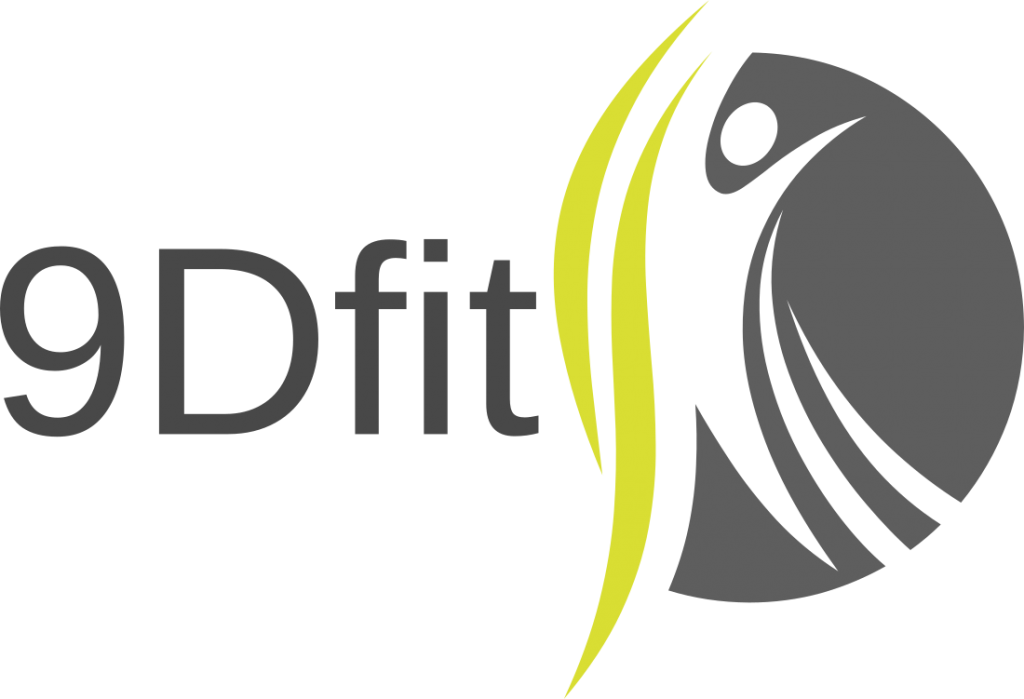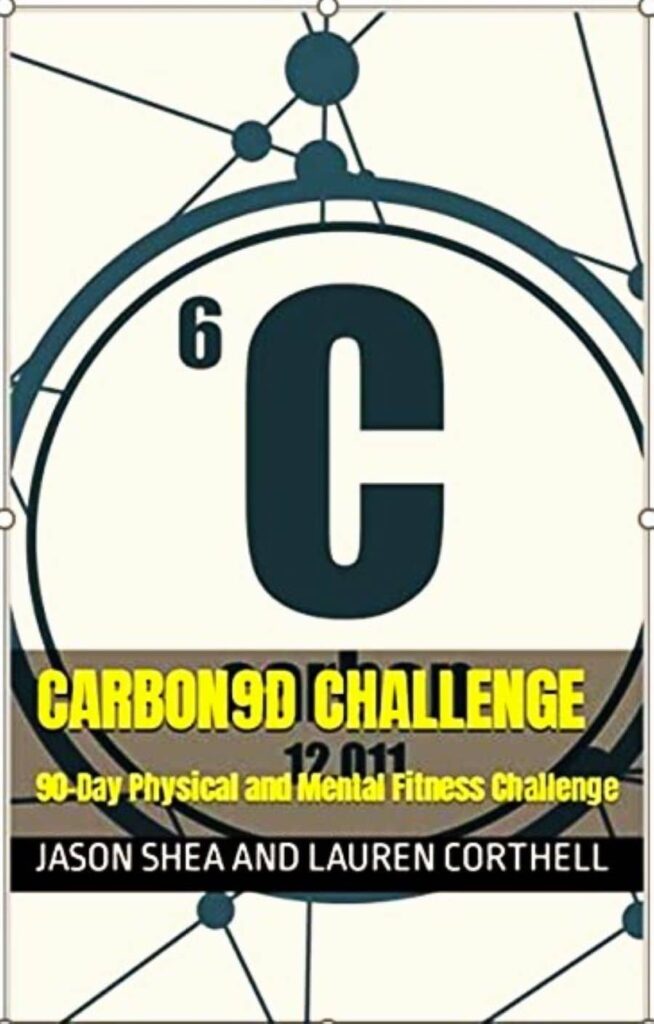By Josette (Puig) Anderson and Jason Shea M.S., CSCS, PICP IV
If your looking for effective tips and strategies on how to tone your body, then you’ve come to the right place.
Does it seem like just yesterday that you were setting your New Year’s resolution to get that lean and toned body you’ve always wanted? Has what started out with the best of intentions slowly dwindled down into a source of anxiety and frustration?
The guilt creeps in every time you walk past the trendy exercise bike that has now been relegated to the role of expensive clothes hanger. The frustration mounts when you open the closet door and see the bands, dumbbells, and collection of workout gadgets collecting dust.
Your Pinterest board and social media posts have morphed from motivating workout videos to dinner and dessert recipes. You can’t even talk about your fast-approaching summer beach vacation without breaking into a cold sweat.
With summer only a couple months away, panic has officially set in.
Don’t we got you covered!
The good news is that summer is still a couple of months away and it’s never too late to get back on track! Wouldn’t it be great to rock that flat stomach, toned legs, and tight glutes, in that new bathing suit this summer?
Learning how to tone your body with effective workouts and sound nutritional strategies can minimize setbacks, maximize adherence and get you moving in the right direction.
Let’s look at a few workouts, training methods, and strategies to get you lean and toned this summer.
1. “Glute Blast” Giant Sets
There was this great study done in 2020, called Gluteus Maximus Activation during Common Strength and Hypertrophy Exercises: A Systematic Review. The researchers looked at all the relevant research studies on glute activity during certain exercises and found that:
- Box Step Up variations had the highest glute activity. According to the researchers the Gluteus Maximus is “responsible for extending the hip joint, while simultaneously maintaining the pelvis level controlling excessive femur adduction and medial rotation (15).” The researchers expressed that a major drawback to step ups is “the higher stability demand may limit the load used, and therefore, may hinder maximal strength and hypertrophy development (16).”
- Squats: According to the researchers “chronic studies have suggested that deeper squats, or a combination of different ranges of motion, induce the most substantial functional and muscular gains, possibly due to more considerable time under tension, mechanical tension, and longer muscle length (16).”
- Barbell Hip Thrusts: One of the more popular glute exercises these days, the barbell hip thrust has been shown to “demonstrate higher GMax excitation levels when compared to any exercise that includes simultaneous knee and hip flexion/extension movement, such as squats and their variations (16).” The researchers found the foot position “is the main factor affecting GMax activation during the barbell hip thrust (16).” The greatest Glute Max activation came when subjects were “oriented to intend to rotate the foot outward (16).”
Other exercises that are guaranteed to leave you a next day friendly reminder (especially while transitioning from sitting to standing) are:
- Bulgarian Split Squats: The 1 1/4 variation: I don’t think we are going to need some scientific studies here to tell you if Bulgarian Split Squats work the glutes or not. If you’ve ever done them, you are aware of the soreness. The constant reminder when transitioning from standing to seated position or vice versa.
- Walking Lunges: With a high knee kick
- Romanian Deadlift/Dumbbell “Death March”: For the purposes of safety while giant setting the single leg RDL or Death March
The “Glute Blast” Giant Set Template
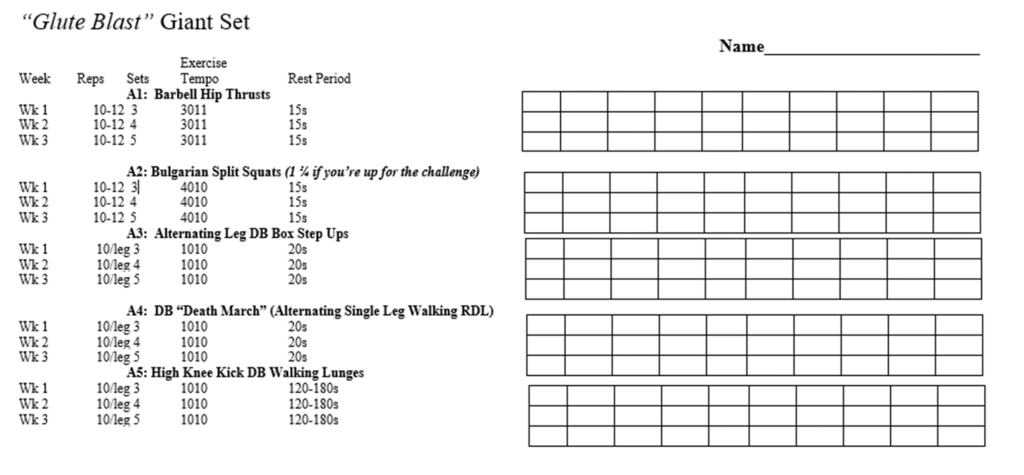
If you can’t get to the gym and want to try a challenging glute and leg toning workout, the JC Leg Crank may fit the bill.
- 24 Body Squats
- 24 Alternating Leg Step Forward Lunges (12/leg)
- 24 Alternating Split Jumps
- 12 Jump Squats
- < 1 minute and 45 seconds
- 6 Leg Cranks in 10 minutes is the best we’ve seen (this was built up to slowly, over a period of weeks/months)
2. Kettlebell Swing “Judy”
How can I get lean and toned in 2-3 months? What exercises are best to get lean? I like sticking with my cardio, but are there good full body gym workouts for women? Perhaps you’ve said or heard these questions before.
For nearly two decades at APECS, we used to run a workout called “Judy“. The workout was used as a “cardio”/conditioning tool for hockey and soccer teams. It consisted of 5-4-3-2-1 rep power cleans @ 5-6RM and 15m shuttle sprints X 3. For the purposes of getting lean and toned for the summer, try the kettlebell swing version. Warning: you may have to foam roll your glutes due to spasming after the 2nd or 3rd round.
How the workout works

A1: Kettlebell Swings X 20: RDL version, try to swing to head height or above (focus on using your glutes and hamstrings).
A2: 15-20 yard shuttle sprint (down and back X 3) (For purposes of structural balance make sure to alternate the leg you decelerate/accelerate off of – for example 15 yard line left leg, start line right leg, 15 yard line left leg, start line right leg, etc)
A3: Pushups X 5-10: Fingertips even with tops of shoulders at bottom, index finger/thumb below or just outside shoulders, armpit angle 45 degrees or less, straight line from shoulders to hips to knees to ankles, head neutral, low back posture neutral, upper arms parallel to the ground (or lower) at the bottom, elbows extended (do not have to lockout) at the top.
Rest 2-4 minutes.
- Try to complete each round as fast as possible while maintaining good technique in the kettlebell swings and pushups
- Focus on effort and intensity during each exercise. Swing with power up to your head or higher, accelerate/sprint as fast as you can, lower slowly and controlled and explode up during pushups. For much more information on Training Intent and why it is important, check out this article.
- First workout, try to complete 2-3 rounds of Judy. Work your way up to 5, completing each in under 90s.
Let’s look at what science says.
When it comes to glute activation warm up protocols, a 2016 study from the Journal of Human Kinetics had subjects do a series of glute warm-up exercises prior to sprinting 10 meters. The exercises were:
- Double Leg Bridges
- Quadruped Lower Extremity Lifts
- Quadruped Hips Abductions
- Side Lying Clams in 60 degree hip flexion
- Side Lying Hip Abduction
- Prone Single Leg Hip Extension
- and Stability Ball Wall Squats
When the study participants warmed up with 15 reps of each of these exercises, their 10 meter sprint times were better (4).
The researchers stated that “the gluteal muscle groups have been the focus of such research as they have been deemed the most important muscles for forward propulsion in sprinting. The gluteal muscles play a major role in running and jumping activities, and studies researching lower limb activities during running and jumping have found the gluteal muscles to be vigorously activated (5).
3. Lyle McDonald’s “Stubborn Fat” Protocol
Whether you like him, hate him, or have never heard of him, Lyle McDonald’s contributions to the fitness industry have been invaluable. His writings and research on ketogenic and cyclical ketogenic dieting (UD2) were ahead of their time. When it came to losing stubborn bodyfat, his Stubborn Fat Solution book is still a trove of great information.

The basis for the Stubborn Fat Protocol revolves around the fact that you need to mobilize (lipolysis) your fat cells first, before you can burn them. Once you have burned your low threshold stubborn fat cells, then you can tap into your high threshold stubborn fat cells.
And how do you do this?
Short (10s) high intensity sprints to mobilize fat cells. Low/moderate intensity (60% HR Max) exercise to burn the fat you just mobilized. And longer (20s) high intensity sprints to mobilize the higher threshold stubborn fat cells.
Here is a breakdown of a sprint “stubborn fat” workout may look like:
A. Warm up: 5 minutes of easy warm up runs
B. 10 Minutes of 10s high intensity sprints (mobilizing fat cells): 10 minutes of 10s sprint/50s recovery. Your goal is to get ten 10s sprints done in 10 minutes with 50 seconds of recovery between sprints. If you do it on an athletic field, try to cover the same distance (yards) per sprint, and use your recovery time to walk/slow jog back to the start line.
C. 5 Minute Rest: Walk around during this time. In theory it is during this time that the fat cells are mobilized and ready to be burned.
D. 20 Minutes of Low/Moderate Intensity (roughly 3-4 RPE) Steady State Cardio: Easy jog for 20 minutes. This is where the fat cells that were mobilized in the 10s sprints are used as fuel and burned.
E: 5 Minute rest: Walk around and recovery during this time.
F: 10 Minutes 30-60s Sprints: In theory, this is where the high threshold, stubborn fat cells are mobilized. Aim for a 1:1 ratio of sprint to rest time here. If you sprint for 30s, rest for 30 seconds. 60s sprints aim for a 60s recovery.
Tips
- Fasted (MCT Oil + Coffee) in the morning will help to ramp up fat burning.
- Acetyl L Carnitine may help with fat burning and ability to work longer/harder
- Feel free to make substitutes. Try it on a fan bike. Add strength training intervals (i.e. Tabata protocols) etc.
- Pick up a copy of McDonald’s book The Stubborn Fat Solution.
Let’s look at some of the science on the fat burning impacts of sprint training.
A team of researchers had men and women perform three 30 second sprints with twenty minutes of rest between them. The women had significantly greater increases in one of the major markers of protein synthesis, meaning they had a better muscle building response to the sprints than the male subjects (9).
A separate study also found that women have a better growth hormone and insulin response to sprint (30s) training as well (8). Why does this matter? Growth hormone is considered the “fountain of youth” hormone, while healthier insulin levels can aid in regulating blood sugar, carb metabolism, bodyfat management, and more.
Other Benefits: Another advantage women may have during sprint training is they “exhibit less muscle fatigue during or after multiple sprint exercise, including cycling and running (8). A study from Sports Medicine found that “females may have a greater ability to restore power between prolonged sprints separated by long recovery periods (2).” The researchers theorized that several factors including hormones, enzyme activities, substrate utilization, nervous system activation, body composition and more could play a role in this.
When it comes to improvements in VO2Max, a 2016 study found that women had more than double (18.7% vs 6.0%) the improvement in Vo2Max after 6 weeks of high intensity sprint interval training (four 20s all out sprints) (1).
4. Add Some Explosiveness
What do sprinters, volleyball players, and pole vaulters have in common when it comes to training?
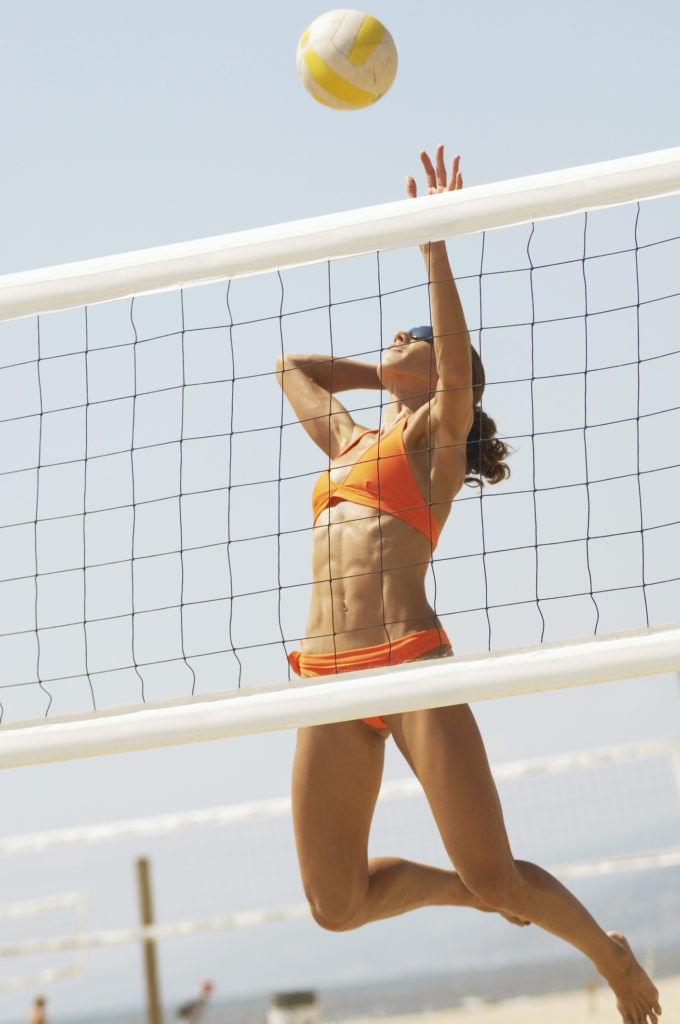
There is something about rapid, explosive contractions of muscle fibers and development of lean, toned muscles.
You’ve probably heard of plyometrics, right? From the Greek word “pleythyein” which translates to augment or increase, Plyometrics were first used in the eastern bloc countries in the mid 1900’s. The Russians and East Germans were using these “top secret jump training” methods to improve explosiveness, speed, and acceleration in of their Olympic athletes.
When some U.S. coaches were invited in to observe these training methods, what they saw were athletes jumping onto and off of platforms, pushing against walls on swing like devices, throwing weights into the air from many different positions, jumping up and grabbing targets suspended from the ceiling, and many other “secret” training methods.
Russian Sport Scientist Yuri Verkoshanky termed what these coaches were witnessing “shock training“. Excited, these coaches went back to the U.S. and began incorporating these methods. According to the late, great Sports Scientist Mel Siff, for an exercise to be true, maximal plyometric, it has to meet 5 criteria:
- Initial Momentum Phase
- Electromechanical Delay Phase (think eccentric or lowering/landing)
- Amortization Phase (switching from eccentric to concentric or landing to jumping)
- Rebound phase (concentric or jumping)
- Final Momentum Phase
From the criteria provided by Siff, the terms maximal and submaximal plyometrics have been used to delineate between different types of plyometrics exercises. Maximal consist of large forces being absorbed creating high levels of something called “musculotendinous” tension. These forces can then be stabilized and released in the opposite direction.
When it comes to plyometrics, not all jump training is considered true, maximal plyometric. Maximal plyometric include depth drops and depth jumps, while submaximal plyometrics include low box jumping, squat jumps, ankle hops, skater hops, low hurdle hops, etc.
So what does this have to do with getting lean and toned muscles? Let’s go back to the skaters, sprinters, volleyball players, pole vaulters and more.
According to a Muscle and Fitness.com article titled Why Plyometrics Workouts are a Faster, More Efficient Way to Burn Fat states that “higher heart rates occur during serious high-intensity work, and plyometrics can help with exercise post-oxygen consumption (EPOC) for hours or days (17).” The article goes on to say that “the average woman can end up in EPOC sometimes for up to 16 hours, and the average man can be in EPOC for between 32 and 48 hours (17).”
A 2012 Army.mil article describes the benefits of jump/plyometric training when it states that ” it is not about building larger muscles, but making your muscles more aerobically active. Because of this, muscles become lean and more explosive with speed. That creates the “ripped” appearance on the body (18).
In a 2020 Q&A from bodybuilding.com, the author describes it like this; “plyometric training challenges your muscles, nerves, and tendons because you need explosive power to perform the repetitions. You’ll burn twice as many calories and have way more fun than plodding away on a treadmill or stair-master (21).”
Lastly, an interview with figure competitor, model, and Biggest Loser trainer Jen Widerstrom sums up the benefits of her plyometric/jumping workout when she states that “this workout is based on dynamic rebounding activity, which creates everything you want: shapely legs, a tight core, a just-pumped upper body. You’ll also build bone density and boost your heart rate using explosive reps and holds (22)”.
What’s science say?
A 2017 study looked at the benefits short-term short term plyometric training had on female futsal athletes. The researchers found that “added to muscle power improvements, this method can also be effective to improve body composition and flexibility parameters because of the high energy expenditure and range of motion necessary to perform jumping exercises (6).”
A recent scientific review, compiling data from several other studies stated that “based on the results of these studies, it seems that plyometric training has a greater potential for inducing increases in muscle size than previously thought. In fact, these effects are similar to those observed with the most potent exercise intervention (11).”
When combining strength and plyometric training, both fat percentage and fat mass decreased after the training program. These reductions are supported by the decrease of triceps, biceps, thigh and calf skinfolds, however, lean body mass significantly increased. This type of conditioning program can also promote significant changes in body composition of highly trained athletes as shown by the decrease in body fat mass found in this study (4).
When it comes to the types of jump exercise and muscle activation, a study from Biomedical Engineering found that “the duration of activation of the hip joint extensor muscles (the gluteal muscles and hamstrings) was longer in the horizontal jump than in the vertical jump. This observation is consistent with the finding that the hip joint was utilized more vigorously in the horizontal jump than in the vertical jump (20).”
Is there a Recommended way to combine Resistance and jump/plyometric training?
French track and field coach Gilles Cometti may have thought so.
The French Contrast Method
The French Contrast Method is a circuit method that places specific exercises in strategic order to allow for the greatest “Postactivation Potentiation (PAP)” stimulus. The exercises are broken down as

A1: Relative Strength/Power Exercise/Heavy Partial/Isometric: Squats, Deadlifts, Power Cleans, Bench Press, etc
A2: Force Oriented Plyo (or sprint): Jumps/Plyo, bounding, sprint, resisted sprints, change of direction, etc
A3: Dynamic/Speed Strength Exercise: Loaded/resisted jumps, throws, sled pushes, Olympic lift derivatives, speed squats, dynamic bench press, etc
A4: Speed or Assisted/Overspeed Exercise: Band assisted jumps, band assisted jump pushups, hurdle hops, etc.
What does the research field say about this method?
A 2018 study out of Spain looked at the immediate potentiation impacts of the French Contrast Method. Thirty-one recreational athletes volunteered for the study. After estimating their 1RM squat, the athletes tested their baseline countermovement jumps height.
After baseline was set, 17 subjects rested 2 minutes and started the French Contrast potentiation protocol while the control group rested for 15 minutes (12).
Looking at longer term impacts, a 2019 looked at 8-weeks of training 3X/week using the French Contrast Method. The researchers saw a 7.31% increase in the triple jump step and 3.85% increase in triple jump distances (7).
A 2019 research study out of Sacred Heart University looked at the impacts of 6 weeks of 2X/week French Contrast training. The researchers saw significant improvements in squat jump and countermovement jump performance (25). Protocol below:
Experimental French Contrast Protocol
| Weeks 1-2 (3 Sets) | Weeks 3-4 (3 Sets) | Weeks 5-6 (3 Sets) |
| A1: Back Squat 3 x 3 @85% 1RMRest 10s A2: CMJ 3 x 3Rest 10s A3: Trap Bar Jumps @30% 1RM 3 x 3Rest 10s A4: Band Assisted Jumps 3 x 4 Rest 5 Mins | A1: Back Squat 3 x 2 @87.5% 1RMRest 10s A2: CMJ 3 x 4Rest 10s A3: Trap Bar Jumps @30% 1RM 3 x 4Rest 10s A4: Band Assisted Jumps 3 x 5 Rest 5 Mins | A1: Back Squat 3 x1 @90% 1RMRest 10s A2: CMJ 3 x 5Rest 10s A3: Trap Bar Jumps @30% 1RM 3 x 5Rest 10s A4: Band Assisted Jumps 3 x 6 Rest 5 Mins |
Now that we have looked at the supportive research, what are some program examples?
Squat Example
| Exercise | Reps | Sets | Tempo | Rest Period |
| A1: Back Squat | 2-3 | 5 | 41X1 | 30s |
| A2: Depth Jumps | 3-5 | 5 | X0X0 | 30s |
| A3: Dynamic Squats w/bands | 4-5 | 5 | 10X0 | 30s |
| A4: High Hurdle Hops | 3-5 | 5 | X0X0 | 180s |
Deadlift Example
| Exercise | Reps | Sets | Tempo | Rest Period |
| A1: Hex Bar Deadlift | 2-3 | 5 | 41X1 | 30s |
| A2: Vertical Jump Testing | 2-3 | 5 | X0X0 | 30s |
| A3: Overhead Backward Med Ball or Kettlebell Throw | 3-5 | 5 | X0X0 | 30s |
| A4: Band Assisted Jumps | 3-5 | 5 | X0X0 | 180s |
Unilateral Lower Body Example
| Exercise | Reps | Sets | Tempo | Rest Period |
| A1: Bulgarian Split Squat | 2-3 | 5 | 30X1 | 30s |
| A2: Split Jumps | 2-3/leg | 5 | X0X0 | 30s |
| A3: Alternating Box Step Ups | 2-3/leg | 5 | X0X0 | 30s |
| A4: Overspeed Sprint (10-20m) | 3-5 | 5 | NA | 180s |
“Not quite French” KB Contrast Circuit Example
| Exercise | Reps | Sets | Tempo | Rest Period |
| A1: KB High Pull from ground | 2-3 | 5 | X0X0 | 30s |
| A2: KB Farmer Carry | 20-50yds | 5 | NA | 30s |
| A3: Overhead Backward Med Ball or KB Throws | 2-5 | 5 | X0X0 | 30s |
| A4: Vertical Jumps with Overhead Goal | 1-3 | 5 | NA | 180s |
5. 100 Rest-Pause Rep Challenge

Disclaimer: Not for beginners or for those who haven’t been working out. You may be very sore or experience “grumpy or angry soreness” for a few days after.
100 Rest-Pause Rep Challenge Guidelines:
- Choose your first body part and exercise (in the template example below we give you chest/barbell bench press first)
- Warm up for a few sets until you reach your 20-30 rep max weight. A good rule of thumb here is if you can do more than 30 reps, the weight may be too light. If you can’t get to 20 reps, the weight may be too heavy.
- When you are ready to begin hit start button on your timer. Your goal is to get all 100 reps at the same weight done in under 10 minutes. Once you are able to achieve sub 8 minutes, you have earned the right to go up in weight.
- Your first set you may get 27 reps. Then take a short rest period and hop back under the bar. On the next try you may get 14 total reps. Then short rest and hop back under the bar again. This time you may only get 9. And so on until you have achieved all 100 reps. Record your time, reps per set, and total sets it took to complete all 100 reps.
- Take a 3-5 minute break and move on to the next exercise.
- Follow the same methodology for each exercise, trying to complete the entire workout in under 60 minutes.

One of the benefits, aside from gaining lean, toned muscle and the feeling of accomplishment that comes with completing this, is that you may feel like you can eat whatever you want, and not pack on any weight. Your appetite may be through the roof for a few days, which might be beneficial for summer beach weekends.
This workout can be quite taxing and your body will need to recover from the shock to your system. You’ll need the calories for repairing and rebuilding your muscle tissue. Here is an example of the day before and day after impact this workout can have on physical readiness and sleep scores (as measured through the Oura Ring).
One of the pioneers of the 100’s method of workout (along with Dr. James Wright) is former Muscle and Fitness contributor Jeff Felicianno. In a 2014 post on intensemuscle.com called 100’s by Jeff Felicianno: The Ultimate Challenge, he describes the original 100’s workout as “this system, a mind boggling experience that changes the athlete’s perception of his pain threshold, was originally designed for combative sport athletes – football players and wrestlers. The overall changes in muscle density, increases in speed and quickness and rehabilitation from injury, coupled with the psychological benefits, were ideal for the first part of off-season training (10).”
Felicianno goes on to explain that “exactly how 100s work remains a mystery, but they do work! The gains made with 100s have shocked even the worst sceptics (10).”
In an post titled Metabolic Madness – You Must Do This Now! by figure competitor and author of How Do I Get Skinny Thighs, Victoria Johnson, she talks about how heavy weight training in the beginning of her bodybuilding career built “big legs of steel that were thicker than she wanted (13).”
In the article, she then describes an eye opening experience she had when she went to a seminar by bodybuilding champ and advocate of the 100’s method, Diana Dennis: “one day I went to a seminar to hear a beautifully sculpted former body builder, Diana Dennis, and I was immediately sold on her ideas of high repetition training using light weights (13).”.
“I don’t want to get big and bulky”
In this interview article with figure competitor and mom Riana Rohmann, she talks about the importance of weight training for women. She expresses that “you will not get bulky! I cannot emphasize that enough. Women, you need to lift weight to gain muscle, but you will gain very little size, if any. Weight training with heavy weights makes you stronger, your metabolism faster and, when combined with a proper diet, it helps you sculpt a leaner physique.
The very muscular women you see in bodybuilding magazines are not the norm. That kind of look is the result of years and years of training, eating a bodybuilder diet and supplementation—not to mention stage lighting, fake tan and oil, flexing and dehydration. It is a look only for the stage, and not a look we carry in our day-to-day lives (19).”
Rest-Pause Training Science
A study from the European Journal of Applied Physiology found that a significantly greater volume of work can be done utilizing the rest pause method (14). A 2018 study saw the same result, leading the researchers to point out that the increased volume seen in the rest-pause method may be more effective at building lean muscle than some traditional training methods (15).
Lessons from the competitive figure world
Now it’s time to address an even more important matter when it comes to getting lean and toned: your nutrition.
You can’t out-train a bad diet. It is amazing how we don’t mind putting the work in at the gym but not at the grocery store.
As a former fitness competitor (and figure coach), I learned that lesson the hard way. The off season was a relaxed approach to nutrition and all about making gains in the gym. But once January rolled around, prepping for contest meant nutrition became the priority.
I knew it was time to get serious about swapping out certain foods and regulating portion sizes. Just as cross-training your workouts is important for making progress, so too is cross-training your nutrition. Otherwise, the body can adapt and stop making progress.
Cross-training your diet is similar to the way you cross-train your workouts; by changing it up and not eating the same amount of calories or macros all the time.
Easing your way into this usually works best. Otherwise, you may feel deprived and fall off the wagon, never seeing the results you want.
Female Physiology
Let’s look at the differences between the female body and male body. You’ll be surprised that it is not just the obvious differences like reproductive system, hormones, and muscles. Take the digestive system for example.
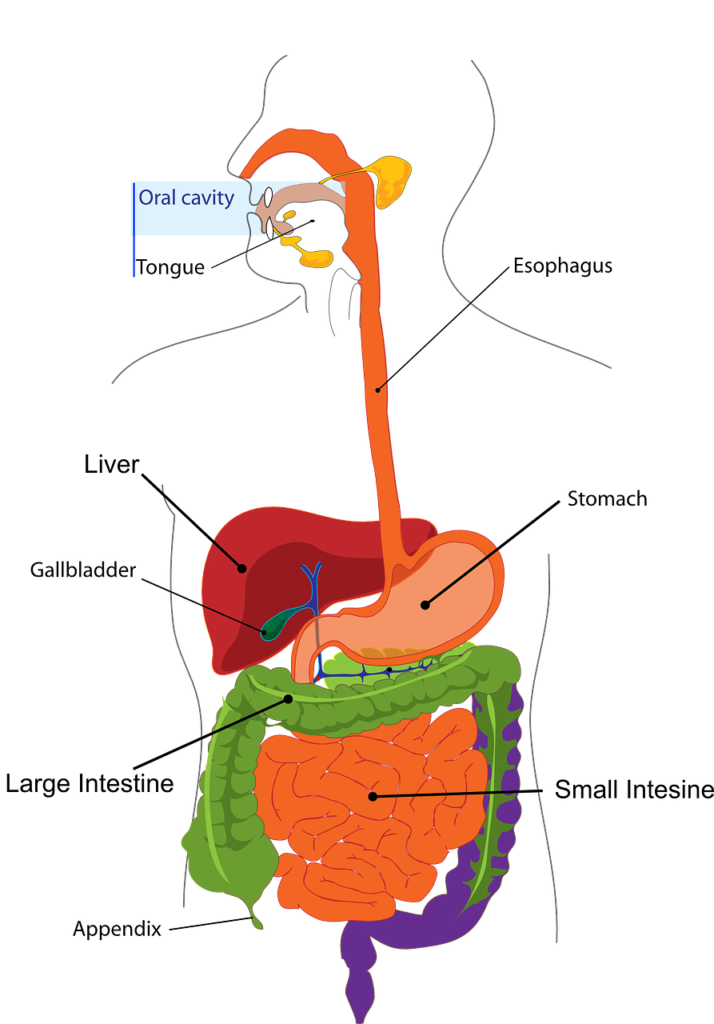
Although both male and female digestive systems are very similar, there are slight differences. These differences may lead to differences in the way some of us react to different foods and medications, while others may lead to differences in bowel movements.
While some of these may be a result of hormonal differences, others are a result of physical make-ups. Changes in the digestive system can also occur after pregnancy and childbirth.
On average, the female colon is 10 centimeters longer than a man’s, forcing some of her colon to reside in the pelvis (23). Do you ever wonder why we have that stubborn lower pooch area? This may be one of the reasons.
Hormonal fluctuations can cause fluid retention, bloating, constipation, and slowed digestion. It can take women an extra 14 hours to move food through the large intestine (24).
Why am I pointing this out? Because we have been taught that losing weight is like a bank account, calories in, calories out. That is of course until science intervenes. There are so many other influences other than math when it comes to leaning out the female body.
It is also important to understand that women need to embrace our differences. Instead of comparing ourselves with men and getting frustrated why we don’t lose weight as fast as men, we need to accept he fact that we are physically different. Our health is not just what we eat. It is also what we digest, what we absorb, and we eliminate.
What we put in our bodies has everything to do with this. Something that I found that really helps, is to identify food intolerances. Foods that cause inflammation can be hard to detect unless you eliminate them temporarily.

I remember prepping for my first fitness show. I was consuming two whey protein shakes per day. My trainer at the time asked me to swap the shakes out for real food. I couldn’t believe how much better I looked and felt when I eliminated whey from my diet.
My abs, which were barely visible at the time, suddenly looked lean and toned. It motivated me to remove other dairy products from my diet like cottage cheese and yogurt. I swapped these out for non-dairy sources of protein.
I even noticed my premenopausal symptoms including hot flashes, cramps, and mood swings, all disappear. Overall, I just felt better and would never have discovered that if I hadn’t eliminated the dairy.
From my experience as a fitness/figure competitor and coach, lets look at a few strategies to help you get lean and toned for the summer.
7 Healthy Tips
1. “If you bite it, you write it”
Keeping a food journal is a great way to keep you honest with what you eat and how much of it. I tell my clients “if you bite it, you write it”. I know there are many convenient apps these days to help keep you on track but there’s something to be said about pen to paper and keeping a food journal that creates more awareness about what we choose to eat.
2. “I feel like I ate all the Frusen Glädjé”
One of the biggest problems I encounter with my clients is portion control. Most of time we underestimate our portions. It’s time to take out the measuring cups and spoons to remind you what a real portion looks like. I highly recommend a food scale as well. Most people don’t realize what 6oz of protein really looks like. This is a great accountability tool to keep you honest.
3. Hydrate

Increase your water intake to half your body weight in ounces of water per day. Women tend to retain water naturally and consuming more water actually helps flush out excess toxins and improves bowel movements as well.
(Quick Tip: A study from the Journal of Clinical Endocrinology and Metabolism found that drinking 16oz of water can increase your metabolic rate by up to 30% within 10 minutes of consumption (3). An added benefit is that this metabolic boost can last 30-40 minutes, or even longer. This means, that drinking 64oz of water per day could spike energy expenditure by approximately 400kjs, which is the equivalent of burning and extra 100 calories per day (3)).
4. Eliminate (or at least significantly minimize) alcohol consumption
Not only does alcohol dramatically decrease fat burning and lead to overeating, but it is counterproductive to maintaining that hard earned muscle tone. If and when you do indulge, choose wisely, picking drinks that don’t spike insulin. These can lead to body fat accumulation.
5. Eliminate sugar
A sweet a week is a treat, a sweet a day is a habit and unfortunately these add up and can prevent us from leaning out.
6. Find your food intolerances
Gluten, dairy, soy, caffeine, FODMAPS, sulfites, fructose. Whether or not you currently have food allergies/intolerances, don’t discount the fact that you may develop them as you get older. In fact, its one of the reasons why we have difficulty losing weight as we age. Hormonal changes, leaky gut, and autoimmune issues are examples of many health issues linked to food intolerances.
7. Intermittent Fasting
incredibly beneficial for digestive health, autoimmune issues, weight loss, and anti-aging.
Bonus Tip: Hormonal changes tend to happen in cycles of 7 years. Being open to making dietary changes throughout your life will not only help keep off unwanted pounds, but extend the quality of life as we age.
Beach Time
Now that you’ve learned some useful tips and workouts on how to tone your body, it’s time to put your knowledge (and motivation) to the test.
Wouldn’t it be great to put the constant guilt and frustration of unaccomplished resolutions/goals behind you?
Imagine confidently walking the beach this summer, knowing you put in the hard work to get the bod you’ve always wanted. Picture being able to enjoy one (or two) of these, guilt-free, at your favorite beach bar this summer, without sabotaging those hard-earned results.

You got this! Time to get to work.
As always, thanks for reading!
To see more great health tips from Josette or Jason, be sure to connect with her on her LinkedIn page (or him on his.)
For much more on topics like this, click on our blog or check out our books on Why You Store Your Fat Where You Do, Workouts For Working People, Lean Body Solutions, Stress Management and more…
References
- Bagley et al. Sex differences in the effects of 12 weeks sprint interval training on body fat mass and the rates of fatty acid oxidation and VO2max during exercise. BMJ Open Sport Exercise and Medicine. 2(1); e000056. 2016.
- Billaut F, Bishop D. Muscle fatigue in males and females during multiple-sprint exercise. Sports Medicine. 39(4); Pp 257-278. 2009.
- Boschmann M et al. Water-Induced Thermogenesis. The Journal of Clinical Endocrinology & Metabolism. 88(12); Pp 6015-6019. 2003.
- Carvalho A et al. Effects of Strength Training Combined with Specific Plyometric exercises on body composition, vertical jump height and lower limb strength development in elite male handball players: a case study. Journal of Human Kinetics. 41; Pp 125-132. 2014.
- Comyns et al. Performance Effects of Repetition Specific Gluteal Activation Protocols on Acceleration in Male Rugby Union Players. Journal of Human Kinetics. 54; Pp 33-42. 2016.
- Da Silva V et al. Effects of short-term plyometric training on physical fitness parameters in female futsal athletes. Journal of Physical Therapy and Science. 29(5); Pp 783-788. 2017.
- Elbadry et al. Effect of the French Contrast Method on Explosive Strength and Kinematic Parameters of the Triple Jump Among Female College Athletes. Journal of Human Kinetics. 69; Pp 225-230. 2019.
- Esbjörnsson et al. Greater growth hormone and insulin response in women than in men during repeated bouts of sprint exercise. Acta Physiology (Oxford). 197(2); Pp 107-115. 2009.
- Esbjörnsson et al. Sprint exercise enhances skeletal muscle p70S6k phosphorylation and more so in women than in men.Acta Physiology (Oxford). 205(3); Pp 411-422. 2012.
- Felicianno J. 100’s by Jeff Felicianno. The Ultimate Challenge. www.intensemuscle.com. 2014.
- Grgic J et al. Effects of plyometric vs resistance training on skeletal muscle hypertrophy: A review. Journal of Sport Health and Science. 10(5); Pp 530-536. 2021.
- Hernández-Preciado et al. Potentiation Effects of the French Contrast Method on Vertical Jumping Ability. Journal of Strength and Conditioning Research. 32(7); Pp 1909-1914. 2018.
- Johnson V. Metabolic Madness – You Must Do This. www.victoriajohnson.com. 2016.
- Korak et al. Effect of rest-pause vs. traditional bench press training on muscle strength, electromyography, and lifting volume in randomized trial protocols. European Journal of Applied Physiology. 117(9); Pp 1891-1896. 2017.
- Korak et al. Effect of a rest-pause vs. traditional squat on electromyography and lifting volume in trained women. European Journal of Applied Physiology. 118(7); Pp 1309-1314. 2018.
- Krause et al. Gluteus Maximus Activation during Common Strength and Hypertrophy Exercises: A Systematic Review. Journal of Sports Science and Medicine. 19(1); pP 195-203. 2020.
- Levey D. WHY PLYOMETRICS WORKOUTS ARE A FASTER, MORE EFFICIENT WAY TO BURN FAT. MuscleandFitness.com.
- Long P. Plyometrics can increase your strength. army.mil. 2012.
- Mathews J. Training Tips From a Figure Competitor. www.acefitness.org. 2013.
- Nagano et al. Optimal coordination of maximal-effort horizontal and vertical jump motions – a computer simulation study. Biomedical Engineering Online. 6; 20. 2007.
- Obadike O. Ask the ripped dude. Bodybuilding.com. 2012.
- Perry C. JEN WIDERSTROM’S PLYOMETRIC CIRCUIT WORKOUT FOR A LEAN, TONED PHYSIQUE. Muscleandfitness.com.
- Saunders B et al. Why is colonoscopy more difficult for women? Gastrointestinal Endoscopy. 43(2); Pp 124-126.
- THE GI GENDER DIVIDE: PART I. San Antonio Gastroenterology Associates. 2018. https://www.sagastro.com/the-gi-gender-divide-part-i/
- Welch et al. EFFECTS OF THE FRENCH CONTRAST METHOD ON MAXIMUM STRENGTH AND VERTICAL JUMPING PERFORMANCE. 14th Annual Coaching and Sport Sciences College. 2019.
